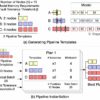Though different fabrication approaches exist, two-step deposition is one of the main experimental techniques now used to make efficient, stable PSCs, especially on the industrial scale. The process involves first depositing lead iodide (PbI2) and then adding halide salts of monovalent cations such as methylammonium iodide (MAI) and formamidinium iodide (FAI) to convert it to perovskite.
While this two-step deposition is better than other options, it is difficult to maintain reproducible high performance and long-term stability when scaling up, mostly because of a lack of control over the fabrication process. Gaining an understanding of the mechanism behind halide perovskite crystallization at the atomic level is therefore essential.
In the paper “A combined molecular dynamics and experimental study of two-step process enabling low-temperature formation of phase-pure α-FAPbI3,” the authors chose to study, to this end, the two-step fabrication of methylammonium lead iodide (MAPbI3) and formamidinium lead iodide (FAPbI3).
While the former is a well-studied system, the latter was chosen because of attractive features including a ∼1.45-eV bandgap, high-charge carrier mobility, and superior thermal stability that appear in its α-FAPbI3 polymorph. The problem with this perovskite however is that the α phase is metastable and the thermodynamic phase transition requires high temperatures of around 150 degrees Celsius. The combined experimental and theoretical study, published in the April 23 issue of Science Advances, uncovered the microscopic details of the crystallization process, leading the way to the discovery of a low-temperature pathway to the fabrication of the material.
While previous experimental research on MAPbI3 revealed that the two-step process occurs via intercalation of the MA+ cations in PbI2 layers followed by a transformation to the perovskite structure via intermediate phases, the experiments couldn’t resolve the nature of these intermediate phases or clarify the underlying atomistic mechanism. Using a molecular dynamics (MD) investigation based on an enhanced sampling technique called metadynamics (WTMetaD), the team found that that transformation takes place through a sequence of intermediates. The theoretical results were in line with experiments, encouraging the researchers to investigate whether a similar process was also behind the transformation of α-FAPbI3. Starting from simulations, they discovered that a two-step process is indeed possible at lower temperatures in this material. A series of in situ X-ray and thin-film experiments then confirmed this result and enabled the low-temperature formation of phase-pure α -FAPbI3 thin films.
Chemical innovation stabilizes best-performing perovskite formulation
More information:
Paramvir Ahlawat et al, A combined molecular dynamics and experimental study of two-step process enabling low-temperature formation of phase-pure α-FAPbI3, Science Advances (2021). DOI: 10.1126/sciadv.abe3326
Provided by
National Centre of Competence in Research (NCCR) MARVEL
Citation:
Low-temperature crystallization of phase-pure α-formamidinium lead iodide enabled by study (2021, May 11)
retrieved 11 May 2021
from https://phys.org/news/2021-05-low-temperature-crystallization-phase-pure-formamidinium-iodide.html
This document is subject to copyright. Apart from any fair dealing for the purpose of private study or research, no
part may be reproduced without the written permission. The content is provided for information purposes only.



